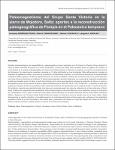Paleomagnestism of the Santa Victoria Group in the Mojotoro Range, Salta: Contributions to the paleogeographic position of Pampia in Early Paleozoic
| dc.contributor.author | Rodríguez Piceda, C | |
| dc.contributor.author | Franceschinis, PR | |
| dc.contributor.author | Escayola, MP | |
| dc.contributor.author | Rapalini, AE | |
| dc.date.accessioned | 2023-05-22T16:19:16Z | |
| dc.date.available | 2023-05-22T16:19:16Z | |
| dc.date.issued | 2018-01-01 | |
| dc.identifier.issn | 0004-4822 | |
| dc.identifier.uri | https://pearl.plymouth.ac.uk/handle/10026.1/20917 | |
| dc.description.abstract |
Sedimentologic magnetofabric paleomagnetic studies were carried out on the early Ordovician La Pedrera Formation (Santa Victoria Group) in the Mojotoro Range Salta province. These studies aim at contributing to a better knowledge on the paleogeographic position of the Pampia block in the Early Paleozoic in relation to the Gondwana supercontinent. Oriented samples were collected from 12 sites distributed in three localities. These outcrops consist of middle to proximal shelf deposits of mainly quarzitic composition. Studies on the anisotropy of magnetic susceptibility (AMS) suggest a depositional fabric in one of these localities meanwhile some tectonic influence cannot be ruled out in the magnetic fabric found in the other two. The paleomagnetic analysis permitted to determine a characteristic magnetic remanence carried by hematite at all twelve sites. From the virtual geomagnetic poles computed at each site a paleomagnetic pole was obtained for the Santa Victoria Group at these localities which is located at 340,4°E 38,3°N A95=8,8°. This pole position suggests that any of the three localities underwent significant tectonic rotations due to the Andean orogeny or pre-vious tectonic events. However, it presents a somewhat lower than expected paleolatitude in comparison to coeval reference poles for Gondwana. Studies of oriented isothermal remanent magnetization suggest that this difference should not be due to inclination errors. On the other hand, the paleomagnetic pole for the Santa Victoria Group disagrees with those previously obtained for the middle to upper Cambrian Mesón Group and the lowermost Ordovician Santa Rosita Formation, to the north of our study localities but still in the same region. These discrepancies can be explained either by the presence of Andean local tectonic rotations around vertical axes in the localities to the north of our study zone or by considering that the hypothetical displacement of Pampia along the Río de la Plata craton margin was already over, or nearly so, by the Early Ordovician. | |
| dc.format.extent | 518-532 | |
| dc.title | Paleomagnestism of the Santa Victoria Group in the Mojotoro Range, Salta: Contributions to the paleogeographic position of Pampia in Early Paleozoic | |
| dc.type | journal-article | |
| dc.type | Journal Article | |
| plymouth.issue | 4 | |
| plymouth.volume | 75 | |
| plymouth.publication-status | Published | |
| plymouth.journal | Revista de la Asociacion Geologica Argentina | |
| plymouth.organisational-group | |Plymouth | |
| plymouth.organisational-group | |Plymouth|Faculty of Science and Engineering | |
| plymouth.organisational-group | |Plymouth|Faculty of Science and Engineering|School of Geography, Earth and Environmental Sciences | |
| plymouth.organisational-group | |Plymouth|Users by role | |
| plymouth.organisational-group | |Plymouth|Users by role|Academics | |
| dcterms.dateAccepted | 2018-01-01 | |
| dc.date.updated | 2023-05-22T16:19:16Z | |
| dc.rights.embargodate | 2023-5-23 | |
| dc.rights.embargoperiod | forever |


